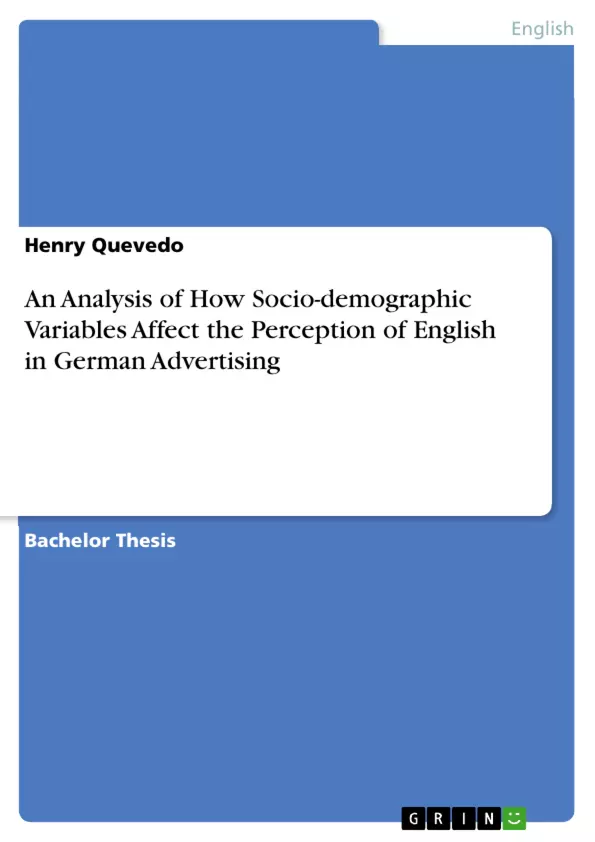The research question of this thesis is how sociodemographic variables affect the perception of English in German Advertising. "English seems to be surrounded by an aura that the German language is apparently missing". With regard to advertising in Germany, it becomes difficult to disagree with this statement by Schlüter. For several decades anglicisms and English expressions have been used for promotional purposes in television-, print-, and online-advertising. "Professional Hair Care for you", "Powered by Emotion" and "Driven by Instinct" are only a few of the many popular slogans in Germany.
The "aura" has been utilized by companies in multiple industries for many years resulting in a consistent growth in the number of anglicisms and English expressions used in the past. This quantitative increase has been exhibited by many researchers, most notably by Schütte. She concluded that from 1951 until 1991 the amount of anglicisms in the slogans, headlines and continuous texts of her corpus of print advertisements grew by over 400%. In her corpus Slogans featured an especially high increase of anglicisms, growing from 5 in 1951 to 153 in 1991. Meder came to similar realization, denoting a great increase of anglicisms used in selected German men’s and women’s magazines in the years 1983, 1993 and 2003. This trend of anglicisms and English expressions being incorporated into the German language – and also advertising – is presumed to continue with the number of expressions deriving from the English language increasing.
Hence, the quantitative presence of the English language in German advertising is virtually undeniable. However, advertising is a form of communication in which the advertiser’s objective is to generate a certain attitude within the recipient towards the advertising object. Thus, it is of substantial value to understand who perceives advertising containing English in the way the advertiser wishes it to be perceived. Past studies that have dealt with the perception of English and anglicisms in advertising oftentimes merely focused on the factor of comprehension. Researchers concluded that the positive perception of English correlated with the person’s command of English. Hence, the question remains who perceives the "aura" of the English language in advertising and which variables influence their respective perception.
Inhaltsverzeichnis (Table of Contents)
- Introduction
- Advertising Language
- The Aim of Advertising
- The Importance of Advertising Language
- The Slogan
- Why is English popular among Advertisers?
- Pragmatic Reasons
- Sociocultural Factors
- Corporate Motivation for using English Slogans
- Varying Language Attitudes towards the Influence of English on the German Language
- Adolescents
- Criticism of Anglicisms and Purist Movement
- Studies on the Perception of Anglicisms and English in Advertising
- Online-Survey: Researching the associative and connotative value of English in Advertising
- Methodology
- Results
- Sociodemographic Characteristics of the Participants
- The associative values of English and German Slogans
- The Connotation of Anglicisms and English in German Advertising
- Discussion
Zielsetzung und Themenschwerpunkte (Objectives and Key Themes)
This bachelor thesis will examine the research question of how sociodemographic characteristics affect the perception of English in German advertising. The associative and connotative value of English in advertising will be examined in relation to sociodemographic data. An empirical study will be conducted, in which an online questionnaire will be sent to 170 people. These people must be native German speakers, have grown up in Germany, and have spent most of their lives in Germany.
- The perception of English in German advertising
- The associative and connotative value of English
- Sociodemographic variables affecting perception
- The use of English in advertising in relation to cultural factors
- The influence of English on the German language
Zusammenfassung der Kapitel (Chapter Summaries)
The first chapter introduces the thesis and provides a brief overview of the research question and hypotheses. It discusses the current state of research on the perception of English in advertising and highlights the importance of understanding how sociodemographic variables affect this perception.
The second chapter provides a detailed analysis of advertising language, its characteristics, and its objectives. It discusses the importance of advertising language, the role of the slogan in advertising, and the reasons why English has become so popular among German advertisers.
Chapter three delves into the reasons why English is used in advertising. It explores both pragmatic reasons, such as the need for international communication, and sociocultural factors, such as the association of English with values like modernity and cosmopolitanism.
The fourth chapter examines varying language attitudes towards the influence of English on the German language. It discusses the positive reception of English among adolescents, the criticism of Anglicisms from purist movements, and past studies on the perception of English in advertising.
Chapter five outlines the methodology of the online survey, which was conducted to investigate the associative and connotative value of English in advertising. The chapter details the specific hypotheses being tested, the structure of the questionnaire, and the requirements of the participants.
Schlüsselwörter (Keywords)
This bachelor thesis focuses on the perception of English in German advertising, examining the influence of sociodemographic variables on the associative and connotative values of English in this context. It explores key themes such as the use of English in advertising, the prevalence of Anglicisms, the cultural and societal factors driving language attitudes, and the varying perceptions of English across different sociodemographic groups.
- Quote paper
- Henry Quevedo (Author), 2018, An Analysis of How Socio-demographic Variables Affect the Perception of English in German Advertising, Munich, GRIN Verlag, https://www.grin.com/document/457533



